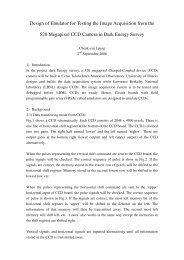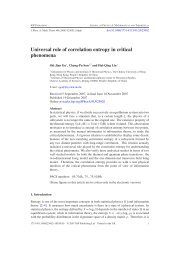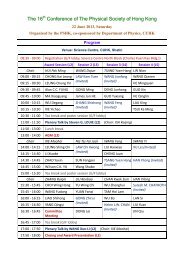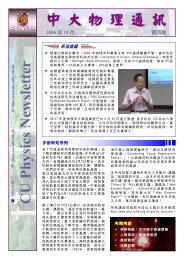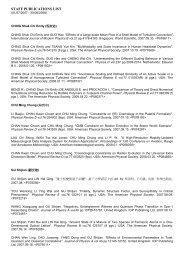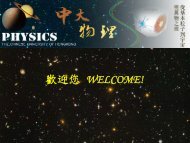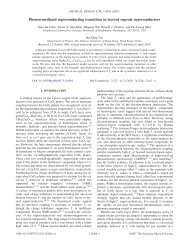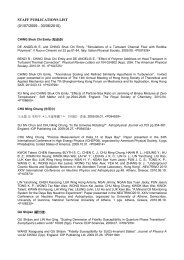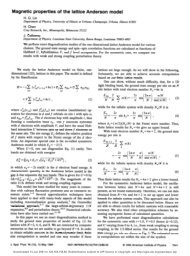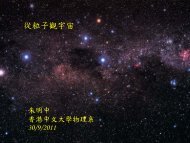19th Issue (Oct-2012) - Department of Physics - The Chinese ...
19th Issue (Oct-2012) - Department of Physics - The Chinese ...
19th Issue (Oct-2012) - Department of Physics - The Chinese ...
Create successful ePaper yourself
Turn your PDF publications into a flip-book with our unique Google optimized e-Paper software.
My Experience as Student and Researcher<br />
Int. J. Mod. Phys. A <strong>2012</strong>.27. Downloaded from www.worldscientific.com<br />
by THE CHINESE UNIVERSITY OF HONG KONG on 10/09/12. For personal use only.<br />
Physical Laws under Space Rotation” to substantiate the intuitive ideas floating in<br />
the literature on the subject. <strong>The</strong> effort was successful and I wrote a short paper<br />
which Teller very much liked. At that time everybody in the department knew that<br />
Frank Yang’s work in Allison’s laboratory was unsuccessful. One day in the spring <strong>of</strong><br />
1948 Teller came to Allison’s laboratory 4 and suggested that I abandon my plan to<br />
write an experimental thesis. He would sponsor my short paper as my Ph.D. thesis<br />
after I had extended it to include relativistic cases. I was at first disheartened by<br />
Teller’s proposal, but after a few days recovered and accepted his suggestion with<br />
relief.<br />
Altogether I spent about 18 to 20 months in Allison’s laboratory. Was that a<br />
complete waste <strong>of</strong> time? No, absolutely not! Through that experience I learned that<br />
the value judgement <strong>of</strong> an experimental physicist was very different from that <strong>of</strong><br />
a theoretical physicist. This understantding influnenced many <strong>of</strong> my later research<br />
work, including the 1956 work on the possibility <strong>of</strong> parity nonconservation and my<br />
1964 paper with T. T. Wu on phenomenological analysis <strong>of</strong> CP invariance. 5<br />
My Ph.D. thesis was the first paper I published concerning invariance and noninvariance<br />
<strong>of</strong> physical laws. Soon after I published a second paper in this field, about<br />
the spin <strong>of</strong> π 0 meson through a careful analysis <strong>of</strong> the group theoretical representation<br />
<strong>of</strong> invariance in field theory. <strong>The</strong>se two papers established me as one <strong>of</strong> the<br />
foremost theorist on the use <strong>of</strong> group theory in analysing symmetry properties. It<br />
was then that this field was beginning and I was very fortunate to have gotten into<br />
it at its infancy.<br />
It is best to enter a research area when it is new and developing. (4)<br />
After I got my Ph.D. degree in the summer <strong>of</strong> 1948, the University <strong>of</strong> Chicago<br />
appointed me as an instructor. At that time the hottest theoretical area <strong>of</strong> research<br />
was renormalization theory. <strong>The</strong> three theory pr<strong>of</strong>essors in Chicago: Fermi, Teller<br />
and Wentzel were not working in this field. <strong>The</strong>refore after one year 1948–1949<br />
I moved to the Institute for Advanced Study (IAS) in Princeton. Before leaving<br />
Chicago Fermi told me it was good to spend some time at the IAS, but the work<br />
there was too academic. It was a bit like a medieval cloister, he said, and was not<br />
a place for long stay. So he suggested that I go to the IAS for one year and then<br />
return to Chicago. I was <strong>of</strong> course totally in agreement with this advice <strong>of</strong> his. But 6<br />
because <strong>of</strong> the convenience <strong>of</strong> dating Miss Tu (later my wife) in New York City,<br />
I did not return to Chicago after one year and instead remained at the IAS for<br />
altogether seventeen years, 1949–1966.<br />
During these seventeen years the four topics that I had worked on by myself<br />
in Chicago, described above, all became successful areas <strong>of</strong> research for me. <strong>The</strong><br />
breakthrough for the first item, Onsager’s work on the Ising Model, had come about<br />
accidentally: 7<br />
One day in early November, 1949, in a ride in the station wagon that<br />
the Institute ran from Palmer Square opposite Princeton Univeristy to the<br />
1230009-9



